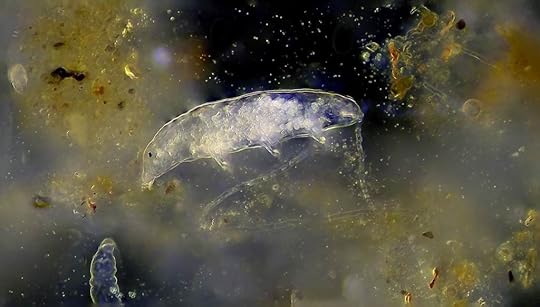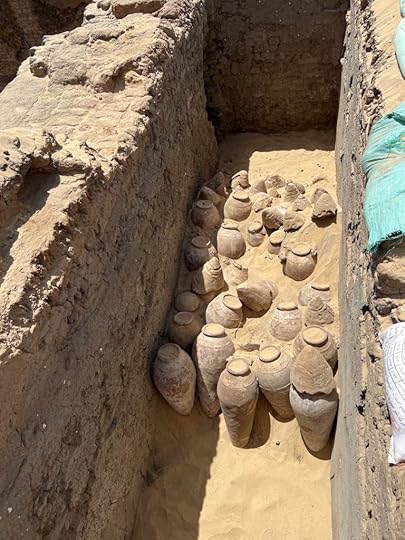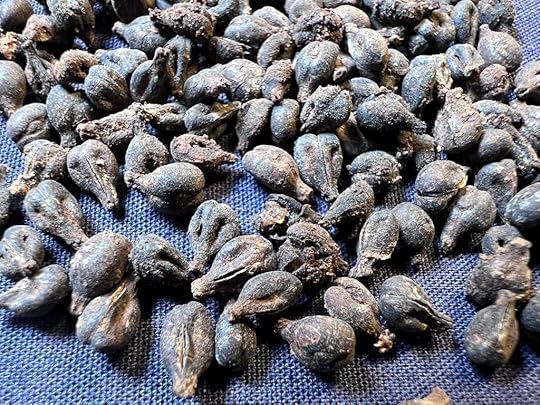Ripley Entertainment Inc.'s Blog
October 30, 2023
CARTOON 10-30-2023
October 29, 2023
CARTOON 10-29-2023
October 28, 2023
CARTOON 10-28-2023
October 27, 2023
CARTOON 10-27-2023
October 26, 2023
Meet The Longest-Living Animals On Earth
Featured in Ripley's Believe It or Not!

Some animals get the biological short end of the stick regarding longevity. Drone ants and houseflies are lucky to live past three to four weeks. And some mayfly species, also known as “one-day insects,” expire within 24 hours of reaching adulthood.
Fortunately, human beings enjoy much longer, fuller lives. But even our +70-year lifespans have nothing on clams, whales, sharks, and some fish. What’s more, a few rare organisms may even be immortal! Check out this amazing list of the longest-living animals on Earth.
Ancient Land AnimalsOn Aldabra Island, in the Seychelles northeast of Madagascar, you’ll find one of the world’s oldest living animals, the Aldabra tortoise. These reptiles can reach upwards of 550 pounds, and their longevity easily tops 150 years.
But under the right conditions, they can live much longer, as an estimated 190-year-old tortoise named Jonathan attests. Jonathan moved from the Seychelles to the island of Saint Helena in 1882, where he’s been going strong ever since.
Embed from Getty Imageswindow.gie=window.gie||function(c){(gie.q=gie.q||[]).push(c)};gie(function(){gie.widgets.load({id:'MebyLASxRD5O4qOvdUSaOA',sig:'L48ztK4RAsDgp5OZVMpsKpuncU0gMDMwdpjjwwgfVAI=',w:'594px',h:'396px',items:'863814180',caption: true ,tld:'com',is360: false })});Other long-lived land animals include chimpanzees and orangutans, which average 50 to 55 years in the wild and longer in captivity. Some feathered friends also lead extraordinarily long lives. A Laysan albatross named Wisdom is at least 71 years old, and Cookie, a pink cockatoo, reached an estimated 83 years before dying.
The only flightless parrot on Earth, kākāpōs are found in New Zealand, where they can live for up to 90 years. Another ancient New Zealander is the tuatara, boasting a 60-to-100-year lifespan. Although tuataras look like lizards, don’t be fooled. They occupy a one-of-a-kind scientific order, Rhynchocephalia.
Embed from Getty Imageswindow.gie=window.gie||function(c){(gie.q=gie.q||[]).push(c)};gie(function(){gie.widgets.load({id:'JWgq0YvmRLZ6aLcYhsHtpQ',sig:'j8zMp1XutsUuMsTe7V6JoXMmS7EYwEkO289SKChJsVA=',w:'453px',h:'594px',items:'1081633896',caption: true ,tld:'com',is360: false })});But a sulfur-crested cockatoo called Cocky Bennett may have outdone even kākāpōs and tuataras. According to some, he reached 120 years before passing away at the Sea Breeze Hotel in Australia in 1916.
Marine Animals Take the CakeDespite their impressive numbers, far fewer land mammals reach three digits than their marine counterparts. It’s hard to know where to start with long-lived ocean fauna. That said, you can’t go wrong with red sea urchins. These spiky beauties live for 100 to 200 years off the American Northwest and Western Canadian coasts.
Bowhead whales also make a couple of centuries look easy. These residents of Arctic and sub-Arctic waters have even been found with stone harpoon tips embedded in their skin, dating to at least the 19th century! Rougheye rockfish take life slow and long, moving with the current for up to 200 years.

Bowhead Whale. Credit: Bering Land Bridge National Preserve Via Wikimedia Commons (CC BY-SA 2.0).
Whales and fish have nothing on a quahog clam dubbed Ming, though. This bivalve led his best life in the waters off Iceland before dredging and freezing cut his 507-year-long existence short. And Greenland sharks, which inhabit the Arctic and North Atlantic, can persist for three to five centuries.
Animals like corals have carbon-dated to at least 4,625 years old! If you’re wondering how corals make the list, bear this in mind. Although they look like plants, corals are made up of the exoskeletons of polyps, a type of invertebrate. Of course, this means their long lifespans are a collaborative effort. Does this disqualify them from the list? We’ll let you decide.

Close up of Glass sponge.
Like corals, sponges comprise colonies of animals. And they can enjoy a surprisingly lengthy stay on the planet, too. One species of glass sponge came in at 11,000 years old! Some scientists believe other species may live even longer.
Forget About Longest Living!If you assume longevity ends at 11,000 years, think again. Scientists have deemed some animals “immortal.” Nope, we’re not talking about werewolves or vampires. Creatures that have discovered a perpetual fountain of youth include Turritopsis dohrnii.
The name doesn’t exactly roll off the tongue. Fortunately, it’s got an easier nickname, the “immortal jellyfish.” Found in the Mediterranean Sea, this jellyfish one ups Benjamin Button and then some. It has mastered the art of reversing its life cycle repeatedly. Under ideal conditions, this rinse-and-repeat life cycle shows no signs of stopping … ever. Sadly, most get noshed on by fish first.
Lobsters may also have the capacity to live forever. Scientists have debated this topic for years. Backing this theory is the case of a 140-year-old lobster caught off the Newfoundland Coast. Like the immortal jellyfish, lobsters prove too tasty for their own good, which has hampered further research.
More Immortal Fauna and an Honorable MentionRegenerating flatworms are another potential immortal animal capable of repairing damaged tissue indefinitely. And Deinococcus radiodurans, a radiation-resistant bacteria, has survived vacuums, acid, dehydration, and cold. Talk about the stuff of true crime! That said, bacteria aren’t technically animals, so consider D. radiodurans an honorable mention.

Tardigrade (water bear) microscope magnification.
Finally, we can’t forget about the adorable, enduring tardigrade. Also known as water bears, these microscopic organisms can enter a state of cryptobiosis. This stops their metabolism indefinitely, allowing them to exist for thousands of years under insane conditions. No wonder they hold the title of the most indestructible species on the planet!
By Engrid Barnett, contributor for Ripleys.com
EXPLORE THE ODD IN PERSON! Discover hundreds of strange and unusual artifacts and get hands-on with unbelievable interactives when you visit a Ripley’s Odditorium!CARTOON 10-26-2023
October 25, 2023
Halloween History: When Did Ghosts Start Saying “Boo”?
Featured in Ripley's Believe It or Not!

Ask most English speakers what a ghost says, and they will probably answer “boo.” It’s a word that people learn in the vernacular at a very young age. From reading a children’s book with parents to choosing a Halloween costume, the word is a Halloween staple.
The phrase dates back several hundred years in Scotland to at least the 18th century. Gilbert Crokatt mentioned the word in the 1738 polemic Scotch Presbyterian Eloquence Display’d. Noting that it was “a word that’s used in the north of Scotland to frighten crying children.”
Behind “Boo”“Boo” was likely carried over to America by Scottish immigrants like other Halloween traditions, including the carving of jack-o’-lanterns. During the mid-1800s, thousands of Scots and Scots-Irish settled in the United States, potentially helping to make “boo” a popular ghost greeting.
English speakers started using the word regularly by at least the 1820s. Other versions of the word “boo,” such as “bo” and “boh,” are featured in literature dating back 500 years. The phrase is not too far off from the Latin word “boāre” and the Greek word “βοãv”, which mean “to cry aloud, roar, shout.”

Portrait of Walter William Skeat. Credit: Wikimedia Commons.
Walter W. Skeat wrote in “Cry Bo to a Goose” in 1870 that kids would ward off aggressive waterfowl by “crying boo.” This would cause the goose to be “defeated.” In this instance, the phrase was used to show assertiveness.
A Word to Frighten KidsScary beings such as the bu-kow and bu-man, also have the “boo” sound in their names. A bu-kow is “any thing frightful, as a scarecrow, applied also to a hobgoblin,” according to the Scottish National Dictionary. The word bogey has also been “used to frighten children.” An 1898 poem describes one of these “boo-man”:
Kings, counsellors, and princes fair,
As weel’s the common ploughman,
Hae maist their pleasures mix’d wi’ care,
An’ dread some muckle boo-man.
Going back even further is the 1565 story “Smyth Whych that Forged Hym a New Dame,” which describes a blacksmith attempting to hammer a woman into a younger version of herself. The blacksmith says, “Speke now, let me se / and say ones bo!”
A Boo-tiful HistoryThe phrase “boo” even sounds a bit alarming. It is a single syllable, so it is easy to say quickly, and some linguists believe the “ooh” sound can be pronounced louder than other vowel sounds, such as “ee.”
People from other countries use other words, such as “uuh” in Spain (which sounds like “ooh” in English) and “hou” in France. However, “boo” is also recognizable in most European countries, albeit it is spelled differently, such as “¡bú!” in Spanish.
Boo also has other meanings—people hiss and “boo” to show discontent at sporting events and other activities. Some people also refer to a boyfriend or girlfriend as their “boo,” which may come from the French word “beau.” However neither of these usages appear to be related to the ghostly word “boo.”
By Noelle Talmon, contributor for Ripleys.com
EXPLORE THE ODD IN PERSON! Discover hundreds of strange and unusual artifacts and get hands-on with unbelievable interactives when you visit a Ripley’s Odditorium!Source: Halloween History: When Did Ghosts Start Saying “Boo”?
CARTOON 10-25-2023
October 24, 2023
Did Archaeologists Just Discover Egypt’s First Female King?
Featured in Ripley's Believe It or Not!

New excavation work at the tomb complex of Queen Meret-Neith in the Abydos desert reveal that the woman was the most powerful female during the period in which she ruled in approximately 3,000 B.C. It’s also possible that she was the first female pharaoh of ancient Egypt!
A Female King?Archaeologist Christiana Köhler from the University of Vienna and her team have been excavating the area and made some significant findings that led to these conclusions, according to a release from Universitat Vien.
The researchers found 5,000-year-old wine and other goods indicating Meret-Neith was the first female pharaoh. Which would mean her reign preceded that of Queen Hatshepsut. She ruled during the 1st Dynasty. And was the only woman to have a monumental tomb in Egypt’s first royal cemetery at Abydos. The new findings give some insight into this unusual woman’s life.

5,000-year-old wine jars in the tomb of Queen Meret-Neith in Abydos during the excavation. The jars are in their original context and some of them are still sealed. (Image credit: E.C. Kӧhler)
Her name means “beloved of the goddess Neith,” and she was the wife of King Djet—the third king of the first dynasty. She was also the mother of his heir, King Den. Previous findings revealed that Meret-Neith’s name was on her son’s tomb in a list of rulers with the title “king’s mother,” suggesting she was Den’s regent while he was a child.
“The very fact of having added her name to the list of kings shows that something highly important had to have happened with Meret-Neith,” Ronald Leprohon, a professor emeritus of Egyptology at the University of Toronto who did not participate in the recent excavations.
Elizabeth Carney, a professor emerita of history at Clemson University in South Carolina, added. “It really would be striking if you had a female king as early as the first dynasty.”
Just How Powerful Was She?Large wine jars were among some of the objects in the queen’s grave. Some of the jars were still sealed and in their original condition. Inscriptions in the grave describe the queen’s role as head of the central government and its offices, including the treasury, which demonstrates how important and historically significant she was to Egypt.

Excellently preserved grape seeds were recently found in sealed wine jars in the tomb of Queen Meret-Neith in Abydos. (Image credit: E.C. Kӧhler)
The Queen’s tomb complex, made of unbaked bricks, clay, and wood, features her burial chamber. It also features the tombs of 41 courtiers and servants. Using new technology, the archaeological team determined that the tombs were constructed over a long period of time in numerous stages. This information combined with other evidence does not support a long-held theory, that has never been proven, that ritual human sacrifice was part of the 1st Dynasty’s royal burial traditions.
There is some debate as to whether Meret-Neith was as powerful as some male Egyptian kings. Particularly because women seldom held reigning positions in ancient Egypt. Regardless, it appears that she had “an unusually high level of authority for a royal woman,” according to Margaret Maitland, principal curator of ancient Mediterranean collections at National Museums Scotland.
Leprohon also noted that the term “pharaoh” did not come into use until the 18th dynasty and later. So even if Meret-Neith ruled Egypt she likely did not have that designation, which translates to “great house.”
Sensing You Want MoreAre you interested in learning more about ancient Egypt? Read about the mummification process, including the removal of the body’s organs, here. You can also learn the real reason why Egyptians chose to preserve the final remains of family members.
And if you love cats, you may be pleased to learn that they were mummified in ancient Egypt for a very good reason—so check this out. In fact, Egyptians loved their feline companions so much, they even lost a battle to a cat-wielding army during the second century!
By Noelle Talmon, contributor for Ripleys.com
EXPLORE THE ODD IN PERSON! Discover hundreds of strange and unusual artifacts and get hands-on with unbelievable interactives when you visit a Ripley’s Odditorium!Source: Did Archaeologists Just Discover Egypt’s First Female King?
CARTOON 10-24-2023
Ripley Entertainment Inc.'s Blog
- Ripley Entertainment Inc.'s profile
- 52 followers










